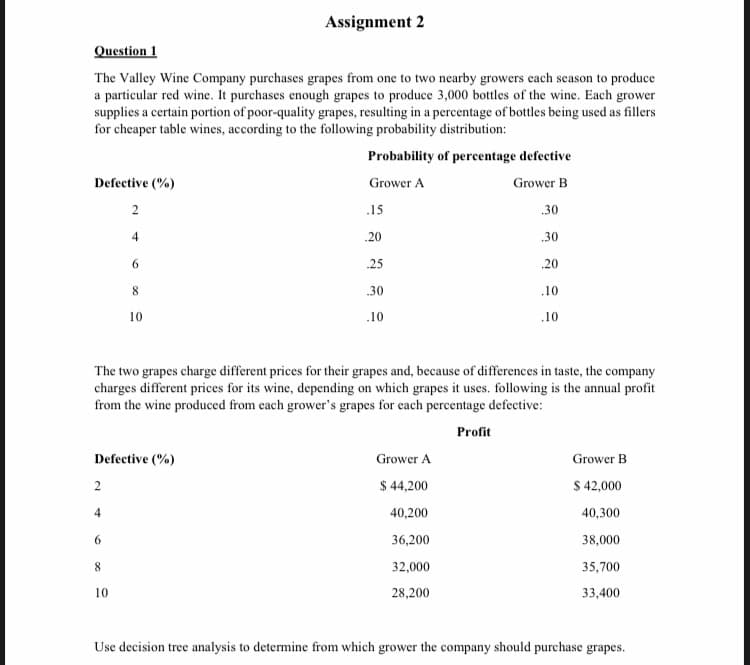Question 1 The Valley Wine Company purchases grapes from one to two nearby growers each season to produce a particular red wine. It purchases enough grapes to produce 3,000 bottles of the wine. Each grower supplies a certain portion of poor-quality grapes, resulting in a percentage of bottles being used as fillers for cheaper table wines, according to the following probability distribution: Probability of percentage defective Grower A Grower B .30 .30 .20 .10 Defective (%) 2 4 6 8 Assignment 2 10 .15 .20 .25 .30 10
Question 1 The Valley Wine Company purchases grapes from one to two nearby growers each season to produce a particular red wine. It purchases enough grapes to produce 3,000 bottles of the wine. Each grower supplies a certain portion of poor-quality grapes, resulting in a percentage of bottles being used as fillers for cheaper table wines, according to the following probability distribution: Probability of percentage defective Grower A Grower B .30 .30 .20 .10 Defective (%) 2 4 6 8 Assignment 2 10 .15 .20 .25 .30 10
Elementary Linear Algebra (MindTap Course List)
8th Edition
ISBN:9781305658004
Author:Ron Larson
Publisher:Ron Larson
Chapter2: Matrices
Section2.5: Markov Chain
Problem 16E: Consumer Preference In a population of 100,000 consumers, there are 20,000 users of Brand A, 30,000...
Related questions
Question

Transcribed Image Text:Assignment 2
Question 1
The Valley Wine Company purchases grapes from one to two nearby growers each season to produce
a particular red wine. It purchases enough grapes to produce 3,000 bottles of the wine. Each grower
supplies a certain portion of poor-quality grapes, resulting in a percentage of bottles being used as fillers
for cheaper table wines, according to the following probability distribution:
Probability of percentage defective
Defective (%)
Grower A
Grower B
2
.15
.30
4
.20
.30
6.
.25
.20
8
30
.10
10
.10
.10
The two grapes charge different prices for their grapes and, because of differences in taste, the company
charges different prices for its wine, depending on which grapes it uses. following is the annual profit
from the wine produced from each grower's grapes for each percentage defective:
Profit
Defective (%)
Grower A
Grower B
$ 44,200
$ 42,000
40,200
40,300
6.
36,200
38,000
8.
32,000
35,700
10
28,200
33,400
Use decision tree analysis to determine from which grower the company should purchase grapes.
Expert Solution
This question has been solved!
Explore an expertly crafted, step-by-step solution for a thorough understanding of key concepts.
Step by step
Solved in 2 steps with 1 images

Recommended textbooks for you

Elementary Linear Algebra (MindTap Course List)
Algebra
ISBN:
9781305658004
Author:
Ron Larson
Publisher:
Cengage Learning

College Algebra
Algebra
ISBN:
9781305115545
Author:
James Stewart, Lothar Redlin, Saleem Watson
Publisher:
Cengage Learning

Algebra and Trigonometry (MindTap Course List)
Algebra
ISBN:
9781305071742
Author:
James Stewart, Lothar Redlin, Saleem Watson
Publisher:
Cengage Learning

Elementary Linear Algebra (MindTap Course List)
Algebra
ISBN:
9781305658004
Author:
Ron Larson
Publisher:
Cengage Learning

College Algebra
Algebra
ISBN:
9781305115545
Author:
James Stewart, Lothar Redlin, Saleem Watson
Publisher:
Cengage Learning

Algebra and Trigonometry (MindTap Course List)
Algebra
ISBN:
9781305071742
Author:
James Stewart, Lothar Redlin, Saleem Watson
Publisher:
Cengage Learning